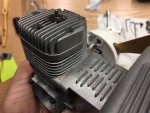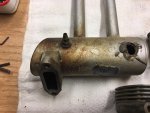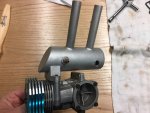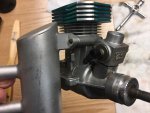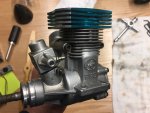Sure, this new thread probably should go in the wet-fuel forum, but the balsa area gets more traffic and glow engines and balsa go together so well! 
A few weeks ago I picked up another "project" plane. SHOCKER! It was taken out of service a couple years ago due to a slightly too aggressive landing, and will eventually be re-built. It came with a Super Tigre .90 glow engine that appears to be in pretty decent shape, other than being all gummed up from not being stored properly. It turned, but only with quite a bit of effort, and the carb was also gummed up tight.
It was taken out of service a couple years ago due to a slightly too aggressive landing, and will eventually be re-built. It came with a Super Tigre .90 glow engine that appears to be in pretty decent shape, other than being all gummed up from not being stored properly. It turned, but only with quite a bit of effort, and the carb was also gummed up tight.
Even though I don't plan on doing anything with the plane for a while I felt the need to get the engine fixed up. Parts availability is pretty slim, so fingers are crossed I can get it done without needing any parts!
The first step was disassembling the parts that would come apart without much difficulty. The head came off, as did the exhaust and carb. The rotating assembly wasn't going to be forced as I don't want to damage the surfaces. Pictures of the carb were taken showing where the limited parts I could remove went so I don't miss anything upon reassembly!
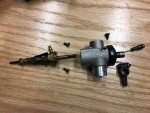
The body and muffler are a bit grubby with age and abuse. Hopefully that changes.

Here are all the pieces, as far as I could get them. Next up was putting all the parts in an old crock pot filled with a 50/50 mix of antifreeze and water, and getting them up to temp for a while. Well, probably a day for the big parts. The antifreeze (old-style green, NOT the new orange variety) does a great job cleaning gunk from the parts, from what I've heard.

After 6 hours I removed the carb and the parts came apart super easily! I washed them with dish detergent to remove the antifreeze, dried them, and started re-assembly. Note the brass parts weren't put through the antifreeze as I have heard it isn't good for the metal. Everything went together easily after getting a coat of oil, and the movement on the throttle is now super-smooth again! I'll post some pics of the rest of the parts as I get to them. Once done I'll give it a hefty coat of oil and then pack it away to wait for the work on the plane.
I'll post some pics of the rest of the parts as I get to them. Once done I'll give it a hefty coat of oil and then pack it away to wait for the work on the plane.
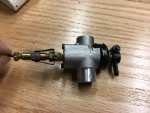
A few weeks ago I picked up another "project" plane. SHOCKER!
Even though I don't plan on doing anything with the plane for a while I felt the need to get the engine fixed up. Parts availability is pretty slim, so fingers are crossed I can get it done without needing any parts!
The first step was disassembling the parts that would come apart without much difficulty. The head came off, as did the exhaust and carb. The rotating assembly wasn't going to be forced as I don't want to damage the surfaces. Pictures of the carb were taken showing where the limited parts I could remove went so I don't miss anything upon reassembly!

The body and muffler are a bit grubby with age and abuse. Hopefully that changes.

Here are all the pieces, as far as I could get them. Next up was putting all the parts in an old crock pot filled with a 50/50 mix of antifreeze and water, and getting them up to temp for a while. Well, probably a day for the big parts. The antifreeze (old-style green, NOT the new orange variety) does a great job cleaning gunk from the parts, from what I've heard.

After 6 hours I removed the carb and the parts came apart super easily! I washed them with dish detergent to remove the antifreeze, dried them, and started re-assembly. Note the brass parts weren't put through the antifreeze as I have heard it isn't good for the metal. Everything went together easily after getting a coat of oil, and the movement on the throttle is now super-smooth again!









